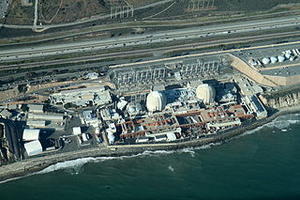Nuclear powerCalifornia’s San Onofre nuclear power plant retired due to safety concerns
Southern California Edison (SCE) has decided it will retire the San Onofre nuclear power plant located on the California coast. The decision comes after officials debated for over a year whether the twin reactors could be safely restarted. The power plant is located in a populated area, with millions living near it.

Aerial view of the soon to be dismantled // Source: commons.wikimedia.org
Southern California Edison (SCE) has decided it will retire the San Onofre nuclear power plant located on the California coast. The decision comes after officials debated for over a year whether the twin reactors could be safely restarted. The plant is located in a populated area, with millions living near it.
CBS News reports that SCE released a statement on Friday saying it will retire the plant due to uncertainty about its future. The plant was facing a litany of regulatory obstacles, investigations, and political opposition.
The plant “has served this region for over 40 years,” Ted Craver, chairman of SCE parent Edison International, said in a statement. “But we have concluded that the continuing uncertainty about when or if (the plant) might return to service was not good for our customers, our investors or the need to plan for our region’s long-term electricity needs.”
The plant was shut down in January 2012 because of radiation leaks. A subsequent evaluation of the plant showed significant damage to hundreds of tubes that carry radioactive water. SCE has spent more than $500 million on repairs and replacement power since the reactors were shut down.
It is not clear at this point how the lost electrical production from the plant will be replaced, but officials say they region will be able to make it through the summer without the plant. The California Public Utilities Commission said it will work with local governments to ensure citizens have enough energy.
SCE was seeking permission from the Nuclear Regulatory Commission (NRC) to restart one of the two reactors in the facility, and run it at reduced power in hopes of stopping the vibration that was damaging the tubing.
“The Nuclear Regulatory Commission is aware of Southern California Edison’s plans to permanently shut down San Onofre, but we are waiting for formal notification of their decision,” Victor Dricks, a spokesman for NRC, told CBS News.
Many of the problems in the plant occurred when a steam generator was installed in 2009 and 2010 as part of a $670 million overhaul. Tests during the overhaul revealed that some of the generator tubes were damaged to the point where they could fail and release radiation.
Friends of the Earth (FOE), an advocacy group that fights the nuclear power industry, applauded the decision.
“We have long said that these reactors are too dangerous to operate and now Edison has agreed. The people of California now have the opportunity to move away from the failed promise of dirty and dangerous nuclear power and replace it with the safe and clean energy provided by the sun and the wind,” FOE’s president, Erich Pica, said in a statement.
Senator Barbara Boxer (D-California), the chairman of the Environment and Public Works Committee, agreed.
“This nuclear plant had a defective redesign and could no longer operate as intended. Modifications to the San Onofre nuclear plant were unsafe and posed a danger to the eight million people living within 50 miles of the plant,” she said in a statement.
“Now that the San Onofre nuclear plant will be permanently shut down, it is essential that this nuclear plant be safely decommissioned and does not become a continuing liability for the community,” Boxer added.
